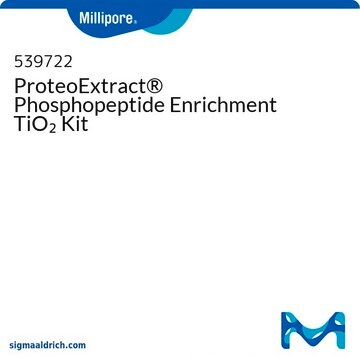Recommended Products
form
suspension
shelf life
2 yr at −20‑0 °C
pH
~5
capacity
≥2 μmol/mL, gel (phosphopeptide)(following a 30 minute incubation at 25°C)
storage temp.
−20°C
General description
Application
- affinity enrichment of phosphopeptides obtained from protein tryptic digests
- direct transfer of phosphocompounds for analysis (HPLC or mass spectrometry)
- enrichment of phosphopeptides by immobilized metal affinity chromatography (IMAC)
Other Notes
Physical form
Legal Information
Storage Class Code
10 - Combustible liquids
WGK
WGK 3
Flash Point(F)
Not applicable
Flash Point(C)
Not applicable
Personal Protective Equipment
Regulatory Listings
Regulatory Listings are mainly provided for chemical products. Only limited information can be provided here for non-chemical products. No entry means none of the components are listed. It is the user’s obligation to ensure the safe and legal use of the product.
EU REACH Annex XVII (Restriction List)
Certificates of Analysis (COA)
Search for Certificates of Analysis (COA) by entering the products Lot/Batch Number. Lot and Batch Numbers can be found on a product’s label following the words ‘Lot’ or ‘Batch’.
Already Own This Product?
Find documentation for the products that you have recently purchased in the Document Library.
Articles
Protein modifications are crucial for disease study. Analysis methods are key.
Our team of scientists has experience in all areas of research including Life Science, Material Science, Chemical Synthesis, Chromatography, Analytical and many others.
Contact Technical Service








